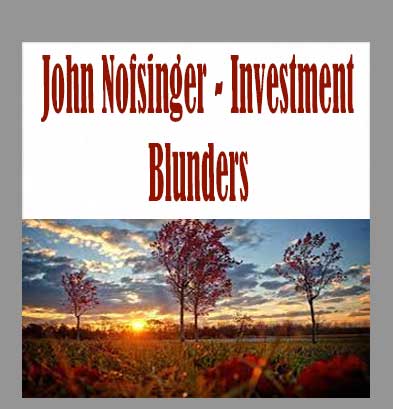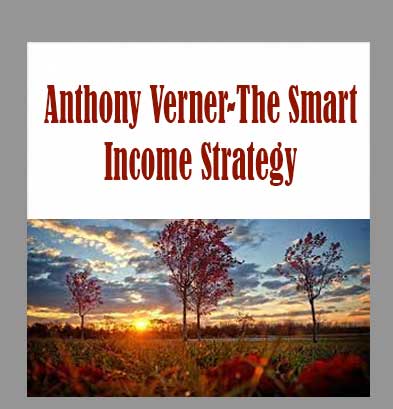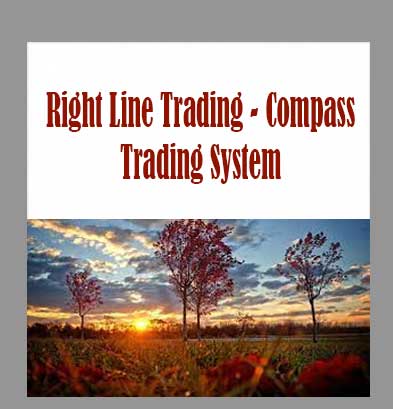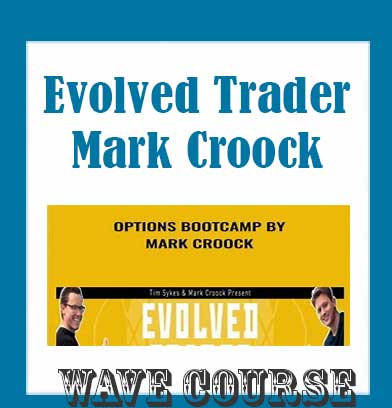Description
John Nofsinger – Investment Blunders download , John Nofsinger – Investment Blunders review , John Nofsinger – Investment Blunders free
John Nofsinger – Investment Blunders
Identifies the widespread investment mistakes that are costing you money right now. Author shows you how to recognize overconfidence and greed in your decision making, avoid throwing good money after bad, and ensure that you have clear goals matched by a clear strategy.
Editorial Reviews
From the Back Cover
We’re all human—especially when we’re investing. And that goes for the “big guys,” too. Dispassionate economic theories say nothing about the emotional decisions we make—or the financial disasters they can cause.
In Investment Blunders of the Rich and Famous … and What You Can Learn from Them, one of the world’s leading experts on investor psychology deconstructs spectacular failures from the world’s most prominent investors. They ought to have known better. But they didn’t. They let overconfidence, hubris, greed, or shortsightedness get the best of them.
Chances are, you’re making some of the same mistakes right now.
Overconfidence and the Long-Term Capital Management hedge fund They were Nobel laureates. They thought they’d found a sure thing. They hadn’t. The Motley Fool and the Foolish Four They were tricked by trends. You can be too. Don’t throw good money after bad: what Baring’s forgot It doesn’t take long for “double-or-nothing” bets to bankrupt you. The prophets: analysts, newsletters, and economists Why expert opinion doesn’t make you money. Avoid the pension blunder that forces you to work longer The fate of Enron employees has befallen others and could happen to you. Fidelity couldn’t time the market—neither can you How the world’s best stock fund missed the world’s best market. Know your investments: lessons from the bankruptcy of Orange County, CA If you can’t understand it, don’t invest in it.”Full of common sense and sophisticated knowledge, John Nofsinger’s Investment Blunders provides individual and professional investors with one of the greatest tips of all time: boost your returns by avoiding mistakes. Trying to remove greed, hubris, moodiness, poor information, and peer pressure from the investment process, Investment Blunders reminds us that our best trades are often those that we don’t do.”—Peter Marber, Columbia University,
and author of From Third World to World Class: The Future of Emerging Markets in the Global Economy”Investment Blunders is a cautionary tale that should be read by anyone investing in the stock market. John Nofsinger describes the kinds of blunders that are made, over and over again, not only by individual investors playing the market but by seasoned brokers, fund managers, and traders. A potent cocktail of hubris, greed, and an unshakeable conviction that ‘I know best’ has led to the downfall of many a financial empire. Read this book, and learn from the mistakes of others before making the same mistakes yourself.”—Morgen Witzel,
editor in chief, Corporate Finance ReviewLessons from the spectacular failures of the world’s most prominent investors!
All investors are subject to the foibles of human psychology. Using other people’s disasters as juicy examples, Investment Blunders identifies the widespread investment mistakes that are costing you money right now.
John R. Nofsinger shows you how to recognize overconfidence and greed in your decision making, avoid throwing good money after bad, and ensure that you have clear goals matched by a clear strategy. You’ll learn why it’s critical to avoid temptations like market timing, why diversification is even more important than you realize, and why you can’t rely on others to understand your investments for you.
Enron proves yet again that even the “smartest” financial sharpshooters can go disastrously awry. But you don’t have to. All you need is a little humility, a little objectivity, and a copy of Investment Blunders.
About the Author
JOHN R. NOFSINGER is a finance professor, Department of Finance, Insurance, and Real Estate at Washington State University and one of the world’s leading experts in investor psychology and behavioral finance.
Written with Richard W. Sias, Nofsinger’s 1997 paper “Herding and Feedback Trading by Institutional Investors” was awarded “Best of the Best” and “Best Paper in Investments” by the Financial Management Association. He has also done advanced research for the New York Stock Exchange and the Association for Investment Management and Research.
He has been interviewed and quoted in financial media including The Wall Street Journal, Fortune, BusinessWeek, SmartMoney, Bloomberg, and the cable news network CNBC, as well as other media from the Washington Post to Wired.
Nofsinger holds a Ph.D. in Finance from Washington State University and taught for five years at Marquette University. His Financial Times Prentice Hall books include Investment Madness: How Psychology Affects Your Investing…and What to Do About It and The Psychology of Investing.
Excerpt. © Reprinted by permission. All rights reserved.
Preface
How can I become a better investor?
This one question is the source of an entire financial advice industry. Magazines, newspapers, books, TV shows, radio shows, and Internet sites are dedicated to the topic. With all this advice, why aren’t we better investors?
Many of these sources of advice manipulate our hopes, dreams, and fears in order to get us to pay attention to their show or buy their magazine. It works. We are often drawn to bad advice simply because it is packaged in an exciting way. I have known financial advisors who were terrible at investing, but had many clients because they had a lot of flash and were great marketers. I have also known financial advisors very good at investing whose client base grew slowly because they didn’t play on prospective clients’ emotions. There is a lot of good advice out there, but it is not always from the sources that draw our attention.
Indeed, the investment industry plays to our emotions as well. Mutual funds focus their advertising on high recent returns. Investment newsletter writers use fear and hope to sell subscriptions. Investment authors offer the way to easy money. It is no wonder that investors develop misconceptions and form bad habits.
I wrote this book to help investors understand the sources of the mistakes they are being led into. Many mistakes are made that have only minor influences on wealth. However, occasionally an investor will fall into a major investment blunder that will seriously affect their life for many years. By reading this book, you should be able to avoid experiencing that blunder (or another one!). As you read the book, you may find that some of the advice you have received is bad. If that is the case, then you may have read this book just in time to avoid your own blunder.
The chapters in this book are grouped into three parts. The first part details many of the problems that investors commonly inflict on themselves. The topic of money (especially losing it!) can bring out strong emotions in people. These emotions can lead to poor choices and further financial problems. In addition, the way the human brain functions frequently leads investors to conclusions that are simply wrong. For example, people think they see patterns and trends in stock prices that are really random, or chaotic. These chapters discuss these emotions and the tricks of the mind. In addition, they illustrate the problems and foolish risks they lead you into.
Many investors turn to investment professionals to get advice on which stocks to buy and when to buy them. There are many analysts, economists, advisers, and other experts who are willing to sell advice. This advice can come to you in the media, through newsletters, or over the Internet. If you are paying for this advice then you had better read Chapter 5, “Profits from the Prophets?” which examines whether you can make profits from these prophets.
The second part of the book describes many of the problems investors face because of the drive to do better than everyone else. Even if you do not feel the need to get the best return, you probably want to at least beat the market (and many of your friends and colleagues). The focus on beating the market causes investors to do things that are harmful to their wealth. Investors try to second-guess the market by timing it. Investors also chase the mutual funds with the top performance over the past month, quarter, or year. The desire to make more money than your neighbor makes you vulnerable to the “get rich quick” scheme. These schemes are named after your desire, not your outcome, because nobody gets rich.
The third part of the book shows that the professionals can make enormous blunders too. They suffer from the same human weaknesses as the rest of us. Even very smart people can blow it. Read the fascinating tales of how respected traders, Nobel Prize Laureates in economics, portfolio managers, and others lost billion of dollars. Read about billions in losses that nearly crashed the world financial system, or losses that bankrupted one of the richest counties in California. Learn of rogue traders that bet the bank on their trades—and lost. While the book describes investment blunders of all types, these dramatic blunders boggle the mind.
How can you avoid making a blunder with your own money while also meeting your investment goals? The last chapter of this book relates a process and strategy for overcoming these problems. It details a disciplined approach to investing that will lead you to your financial goals.
Excerpt. © Reprinted by permission. All rights reserved.
Preface
How can I become a better investor?
This one question is the source of an entire financial advice industry. Magazines, newspapers, books, TV shows, radio shows, and Internet sites are dedicated to the topic. With all this advice, why aren’t we better investors?
Many of these sources of advice manipulate our hopes, dreams, and fears in order to get us to pay attention to their show or buy their magazine. It works. We are often drawn to bad advice simply because it is packaged in an exciting way. I have known financial advisors who were terrible at investing, but had many clients because they had a lot of flash and were great marketers. I have also known financial advisors very good at investing whose client base grew slowly because they didn’t play on prospective clients’ emotions. There is a lot of good advice out there, but it is not always from the sources that draw our attention.
Indeed, the investment industry plays to our emotions as well. Mutual funds focus their advertising on high recent returns. Investment newsletter writers use fear and hope to sell subscriptions. Investment authors offer the way to easy money. It is no wonder that investors develop misconceptions and form bad habits.
I wrote this book to help investors understand the sources of the mistakes they are being led into. Many mistakes are made that have only minor influences on wealth. However, occasionally an investor will fall into a major investment blunder that will seriously affect their life for many years. By reading this book, you should be able to avoid experiencing that blunder (or another one!). As you read the book, you may find that some of the advice you have received is bad. If that is the case, then you may have read this book just in time to avoid your own blunder.
The chapters in this book are grouped into three parts. The first part details many of the problems that investors commonly inflict on themselves. The topic of money (especially losing it!) can bring out strong emotions in people. These emotions can lead to poor choices and further financial problems. In addition, the way the human brain functions frequently leads investors to conclusions that are simply wrong. For example, people think they see patterns and trends in stock prices that are really random, or chaotic. These chapters discuss these emotions and the tricks of the mind. In addition, they illustrate the problems and foolish risks they lead you into.
Many investors turn to investment professionals to get advice on which stocks to buy and when to buy them. There are many analysts, economists, advisers, and other experts who are willing to sell advice. This advice can come to you in the media, through newsletters, or over the Internet. If you are paying for this advice then you had better read Chapter 5, “Profits from the Prophets?” which examines whether you can make profits from these prophets.
The second part of the book describes many of the problems investors face because of the drive to do better than everyone else. Even if you do not feel the need to get the best return, you probably want to at least beat the market (and many of your friends and colleagues). The focus on beating the market causes investors to do things that are harmful to their wealth. Investors try to second-guess the market by timing it. Investors also chase the mutual funds with the top performance over the past month, quarter, or year. The desire to make more money than your neighbor makes you vulnerable to the “get rich quick” scheme. These schemes are named after your desire, not your outcome, because nobody gets rich.
The third part of the book shows that the professionals can make enormous blunders too. They suffer from the same human weaknesses as the rest of us. Even very smart people can blow it. Read the fascinating tales of how respected traders, Nobel Prize Laureates in economics, portfolio managers, and others lost billion of dollars. Read about billions in losses that nearly crashed the world financial system, or losses that bankrupted one of the richest counties in California. Learn of rogue traders that bet the bank on their trades—and lost. While the book describes investment blunders of all types, these dramatic blunders boggle the mind.
How can you avoid making a blunder with your own money while also meeting your investment goals? The last chapter of this book relates a process and strategy for overcoming these problems. It details a disciplined approach to investing that will lead you to your financial goals.
Product details
Publisher : Financial Times Management; 1st edition (June 15, 2002)
Language : English
About the author
John R. Nofsinger
Dr. Nofsinger is one of the world’s leading experts in behavioral finance. He has authored/coauthored fourteen finance trade books, textbooks, and scholarly books that have been translated into eleven languages. He also a prolific scholar who has published over 70 articles in prestigious scholarly journals and practitioner journals. Dr. Nofsinger is also a frequent speaker on behavioral and financial topics.
Top reviews from the United States
Steven Lee
4.0 out of 5 stars Entertaining and Interesting
One thing you should realize about this book is that it is not a detailed investment book. If you are looking for such a book you should pick up something by Bill Bernstein or Jack Bogle. The vast majority of this book deals with behavioral finance (and the stupid mistakes people can make as a result) and colorful stories of huge investment blunders that modern professionals have made. I think it is critical to understand the mistakes that people can make because of their mood, fears, unbridled optimism, etc. This book tries to adddress much of that. The chapters dealing with huge plunders that professionals have made are entertaining and informative.
Only one chapter in this book deals with specific investment strategy. Of course, it deals with the subject in a summary fashion. That being said, however, it actually is not a bad chapter, especially if this is not the first investment book you have read. One thing I must point out is that I think that the author’s suggested asset allocation chart is wrong. His chart on page 261 indicates that if you want a 10% return over a period of time you should invest 50% of your money in bonds, 12% in cash and 38% in equities. I think if you followed his suggestion you would get a return significantly lower than 10%. I think the chart inflates the returns you should expect for any given allocation and should be ignored. With this one caveat, I highly recommend this book.
Frequently Asked Questions:
- Innovative Business Model:
- Embrace the reality of a genuine business! Our approach involves forming a group buy, where we collectively share the costs among members. Using these funds, we purchase sought-after courses from sale pages and make them accessible to individuals facing financial constraints. Despite potential reservations from the authors, our customers appreciate the affordability and accessibility we provide.
- The Legal Landscape: Yes and No:
- The legality of our operations falls into a gray area. While we lack explicit approval from the course authors for resale, there’s a technicality at play. When procuring the course, the author didn’t specify any restrictions on resale. This legal nuance presents both an opportunity for us and a boon for those seeking budget-friendly access.
- Quality Assurance: Unveiling the Real Deal:
- Delving into the heart of the matter – quality. Acquiring the course directly from the sale page ensures that all documents and materials are identical to those obtained through conventional means. However, our differentiator lies in going beyond personal study; we take an extra step by reselling. It’s important to note that we are not the official course providers, meaning certain premium services aren’t included in our package:
- No coaching calls or scheduled sessions with the author.
- No access to the author’s private Facebook group or web portal.
- No entry to the author’s exclusive membership forum.
- No direct email support from the author or their team.
We operate independently, aiming to bridge the affordability gap without the additional services offered by official course channels. Your understanding of our unique approach is greatly appreciated.
- Delving into the heart of the matter – quality. Acquiring the course directly from the sale page ensures that all documents and materials are identical to those obtained through conventional means. However, our differentiator lies in going beyond personal study; we take an extra step by reselling. It’s important to note that we are not the official course providers, meaning certain premium services aren’t included in our package:
Refund is acceptable:
- Firstly, item is not as explained
- Secondly, Item do not work the way it should.
- Thirdly, and most importantly, support extension can not be used.
Thank you for choosing us! We’re so happy that you feel comfortable enough with us to forward your business here.








Reviews
There are no reviews yet.